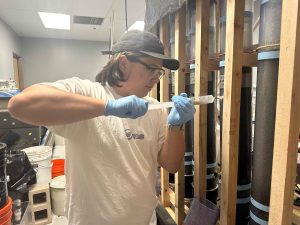Modeling phase launched in effort to open ‘black box’ of BMP mechanistic processes

SCCWRP and its partners have begun working to model the mechanistic inner processes by which a ubiquitous class of stormwater BMPs known as biofiltration systems removes pollutants from runoff – a key milestone in an ongoing study working to develop a next generation of BMP modeling tools that reflect the specific internal processes driving pollutant removal.
The study’s modeling phase, which kicked off in November, follows the successful completion of laboratory-scale experiments last fall that generated quantifiable insights about how biofiltration BMPs treat contamination in runoff.
Significantly, the study’s laboratory phase already has generated insights that are expected to be immediately actionable to stormwater managers who design BMPs. Through the lab work, researchers identified a pair of easy-to-measure properties of biofiltration treatment media that can serve as reliable indicators of how effectively the media will remove dissolved copper from runoff; the findings will be described in a forthcoming journal article.
Meanwhile, researchers are moving forward with developing BMP mechanistic modeling tools using data from the study’s laboratory phase. The models will be capable of predicting pollutant effluent concentrations and removal capacity of biofiltration BMPs based on specific measurable properties of the biofiltration media used to construct the BMP.
Once the modeling tools are built, their predictive capabilities will be validated with monitoring data reflecting how biofiltration BMPs perform in the field.
The mechanistic inner processes by which structural BMPs like biofiltration systems remove contaminants have historically been a “black box” – with researchers routinely measuring the runoff entering and exiting the BMP, but not focusing what happens inside the BMP as this runoff is being treated, including understanding the influence that different BMP design specifications have on performance.
In the absence of understanding BMP mechanistic processes, common BMP modeling practice for water quality is to use assumptions that rely on rules of thumb and best professional judgment. Consequently, these predictions tend to have a high degree of uncertainty associated with them.
A biofiltration BMP is an engineered system consisting of engineered media, plus hydrologic and hydraulic controls, that are intended to remove contaminants such as sediment, metals, and nutrients as runoff filters gradually through the system.
By developing a next generation of mechanistic process-focused BMP modeling tools, researchers hope to enable managers to better pinpoint BMP design specifications and maintenance regimes that will optimize long-term BMP performance.
Already, the study’s laboratory phase has identified two easily measurable biofiltration media properties – cation exchange capacity and bulk density – that are strong indicators of the media’s capacity to remove dissolved copper from stormwater runoff. Once the findings are peer-reviewed and published, researchers envision BMP designers being able to routinely measure these two properties for all of their own biofiltration media, then to estimate the relative treatment effectiveness of different combinations and ratios of different types of biofiltration media.
Historically, BMP designers have lacked the tools for predicting the effectiveness of specific media; all media that bear the same name (e.g., biochar, zeolite, sand) have long been assumed to provide equal treatment effectiveness.
The BMP mechanistic processes study, which is a joint collaboration between SCCWRP, the State Water Board, and the Southern California Stormwater Monitoring Coalition (SMC), began with a laboratory-based phase that enabled researchers to quantify mechanistic processes under controlled environmental conditions.
For the lab phase, researchers constructed flow-through columns filled with different types of BMP treatment media to mimic how two types of contaminants are removed as runoff flows through a biofiltration BMP: dissolved copper, a common runoff contaminant, and per- and poly-fluoroalkyl substances (PFAS), an emerging class of contaminants detected in stormwater runoff.
These column studies were designed to simulate real-world BMP operating conditions, including runoff infiltration rate and the complex matrix of contaminants found in Southern California runoff.
SCCWRP is finalizing a workplan for the field monitoring model validation phase, which will kick off in February.
For more information, contact Dr. Elizabeth Fassman-Beck and Dr. Danhui Xin.
More news related to: Emerging Contaminants, Runoff Water Quality, Southern California Stormwater Monitoring Coalition, Stormwater BMPs, Top News